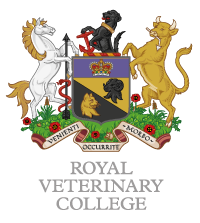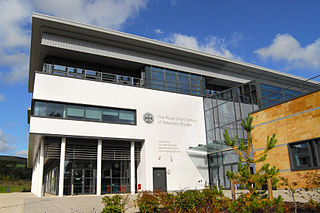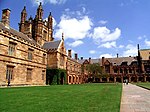Related Research Articles

The Royal Veterinary College is a veterinary school located in London and a member institution of the federal University of London. The RVC was founded in 1791 and joined the University of London in 1949. It is the oldest and largest Veterinary school in the United Kingdom, and one of only 11 in the country where students can study to become a vet.

Martin Joseph Fettman is an American pathologist and researcher who flew on NASA Space Shuttle mission STS-58 aboard the Space Shuttle Columbia as a Payload Specialist.

The New York State College of Veterinary Medicine at Cornell University is a statutory college of veterinary medicine at Cornell University, in Ithaca, New York. Founded in 1894, it is the first statutory college of the State University of New York (SUNY) system.
The Virginia–Maryland College of Veterinary Medicine is the veterinary school of Virginia Tech and the University of Maryland, College Park - both of which are public research universities in the Commonwealth of Virginia and the State of Maryland, respectively. The college was created as a joint venture of the two universities and their respective state governments in order to fill the need for veterinary medicine education in both states. Students from both states are considered "in-state" students for admissions and tuition purposes.
The Texas A&M University School of Veterinary Medicine & Biomedical Sciences is the veterinary school of Texas A&M University, a public research university in College Station, Texas. It was founded in 1916 and is one of only 31 colleges or schools of veterinary medicine in the United States and Canada. It is consistently ranked as one of the top 5 veterinary schools in the country, according to U.S. News. The school offers an undergraduate program in Biomedical Sciences, a professional Doctor of Veterinary Medicine program, and numerous graduate programs relating to veterinary medicine and epidemiology.

The Atlantic Veterinary College (AVC) is an accredited and globally recognized veterinary school in the Faculty of Veterinary Medicine at University of Prince Edward Island, located in Charlottetown, Prince Edward Island, Canada.

The University of Veterinary Science, Yezin, located in Yezin in the outskirts of Naypyidaw, is the only university of veterinary science in Myanmar (Burma). The university offers a six-year Bachelor of Veterinary Science (BVSc) program. Since 2014, UVS renamed its BVSc degree to DVM and, since then, all new graduates received DVM title instead. It accepts about 100 students a year. It has launched a four-year Bachelor of Animal Science (BASc) program since 2014. It accepts about 100 students a year. It also offers graduate degree programs. The language of instruction at UVS is English.

Veterinary education is the tertiary education of veterinarians. To become a veterinarian, one must first complete a degree in veterinary medicine Doctor of Veterinary Medicine.

The Royal (Dick) School of Veterinary Studies, commonly referred to as the Dick Vet, is the University of Edinburgh's vet school. It is part of the College of Medicine and Veterinary Medicine.
The University of Georgia College of Veterinary Medicine is a college within the University of Georgia (UGA) in Athens, Georgia, United States and is a top 10 ranked veterinary school.

The University of Veterinary and Animal Sciences, or UVAS originally known as Lahore Veterinary College, is a public university located in Lahore, Punjab, Pakistan.
The University of Liverpool School of Veterinary Science was the first veterinary school in the United Kingdom to be incorporated into a university. The school's teaching, treatment and research facilities are on the main campus and at Leahurst on the Wirral Peninsula, approximately 12 miles outside Liverpool.
North Carolina State University College of Veterinary Medicine is an American educational institution located in Raleigh, North Carolina that offers master's and doctorate-level degree programs; interdisciplinary research in a range of veterinary and comparative medicine topics through centers, institutes, programs and laboratories; and external engagement through public service programs and activities.
The College of Veterinary Sciences & Animal Husbandry, one of the constituent colleges of the Central Agricultural University, was established through the promulgation of an ordinance and became functional with the admission of first batch of students to BVSc & AH degree course in the 1997. It is near Aizawl in the state of Mizoram. Lalnuntluangi Hmar is the dean of the college.
The Bachelor of Veterinary Science, "Bachelor of Veterinary Medicine" (BVetMed), or "Bachelor of Veterinary Medicine and Surgery" is a degree for studies in veterinary medicine in the United Kingdom, Australia, and several other countries outside the United States and Canada. These degrees qualify one to practice as a veterinarian in the US if the degree is conferred from an American Veterinary Medical Association (AVMA) accredited school and the candidate passes the North American Veterinary Licensing Examination (NAVLE), just as any other US and Canada graduate. They are equivalent to DVM/VMD degrees; the main equalizer being licensure in the US. On 5 March 2015, the Royal College of Veterinary Surgeons (RCVS) Council made the decision to allow UK veterinarians to use the courtesy title "doctor", to align with international practices. The RCVS president said of the change: “Whether one regards the decision as correcting a historical anomaly or simply providing greater clarity at home and abroad, there is no doubt that the issue has generated huge interest".
Ross University School of Veterinary Medicine (RUSVM), founded in 1982, is a university offering the Doctor of Veterinary Medicine degree. As of 2014, RUSVM began offering Master of Science and PhD degrees in public health, global animal health, conservation medicine, and other research areas supported by the school. The school is located in St. Kitts. Administrative offices are located in Downers Grove, IL. RUSVM is accredited by the American Veterinary Medical Association Council on Education.
The College of Veterinary Medicine (CVM) is one of the 11 degree-granting units of the University of the Philippines at Los Baños. It is the country's first veterinary school.
The Faculty of Veterinary Science is a faculty of the University of Pretoria. Founded in 1920, it is the second oldest veterinary faculty in Africa. With the exception of the faculties in Khartoum, and Cairo, all the other African faculties were established after 1960. It is the only one of its kind in South Africa and is one of 33 veterinary faculties in Africa.

The University of Pennsylvania School of Veterinary Medicine, commonly referred to as Penn Vet, is the veterinary school of the University of Pennsylvania. Penn Vet is one of only two Ivy League veterinary schools in the United States. Established in 1884, Penn Vet is the only veterinary school developed in association with a medical school, and is one of only four private veterinary schools in the nation.
The UCPH School of Veterinary Medicine and Animal Science is part of the Faculty of Health and Medical Sciences at University of Copenhagen (UCPH) in Copenhagen, Denmark. Based at the university's Frederiksberg Campus in Frederiksberg and the Taastrup Campus in the suburb of Taastrup, the school originates in the Royal Veterinary and Agricultural University which was merged into UCPH in 2007. It is the only institution that trains veterinarians in Denmark. The programme is taught in two veterinary teaching hospitals, one at the Frederiksberg Campus and one for large animals in Taastrup.
References
- 1 2 "Veterinary Science Prospectus 2010" (PDF). Faculty of Veterinary Science, University of Sydney. Retrieved 19 February 2011.
- 1 2 3 4 5 6 7 8 9 "Our History - About the Faculty - The University of Sydney". The University of Sydney. Retrieved 19 February 2011.
- ↑ "Historical Timeline 1910-2010". The University of Sydney. Retrieved 19 February 2011.
- 1 2 "Bachelor of Veterinary Biology/Doctor of Veterinary Medicine handbook" (PDF). Faculty of Veterinary Science - The University of Sydney. Retrieved 24 August 2015.
- ↑ "Is the Degree Recognised?". The University of Sydney. Retrieved 19 February 2011.
- ↑ "Heritage:J.D. Stewart Building". Campus Infrastructure Heritage - The University of Sydney. Retrieved 19 February 2011.
- ↑ "World First Robotic Dairy". The Farm Trader. Retrieved 19 February 2011.
- ↑ "Sydney University Veterinary Society page". VetSoc. Retrieved 19 February 2011.
- ↑ "Dr. Chris Brown's Biography". Network Ten. Retrieved 19 February 2011.
